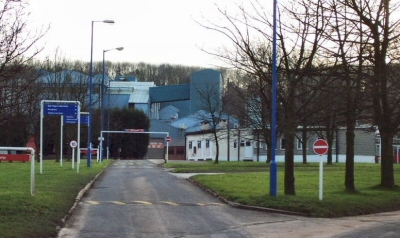Local Industries
Gypsum Mining
South of the river Dove between Uttoxeter and Tutbury, the predominant mineral is gypsum. For hundreds of years this stone has been quarried or mined for fashioning into alabaster or manufacturing gypsum plaster. The Normans used alabaster in the west doorway of Tutbury Priory Church, foundations of the castle and decorations inside. John O' Gaunt ordered blocks of gypsum from Fauld for an alabaster monument in memory of his first wife, which was placed in old St. Paul's Cathedral.
In the 16th and 17th centuries, the school of alabasterers at Burton used local stone for their ecclesiastical monuments and family memorials, but it was not until late in the 18th century that the industry was put on a commercial footing at Fauld.
A hundred years later John Staton changed from quarrying to mining stone, and was quickly followed by Peter Ford on the Tutbury side of the hill.
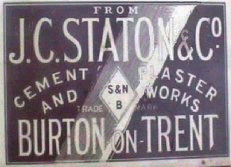 There
were three working gypsum mines in Hanbury Parish in 1894. One operated
by J C Staton at Fauld, one by Peter Ford & Son, also at Fauld but further
to the East and close to the area devastated by the Fauld Explosion. A third
mine sited near Draycott-in-the-Clay, though still in Hanbury Parish, was
owned by the Needwood Plaster and Cement Company.
There
were three working gypsum mines in Hanbury Parish in 1894. One operated
by J C Staton at Fauld, one by Peter Ford & Son, also at Fauld but further
to the East and close to the area devastated by the Fauld Explosion. A third
mine sited near Draycott-in-the-Clay, though still in Hanbury Parish, was
owned by the Needwood Plaster and Cement Company.
Staton's mine was producing over 10000 tons a year of plaster products around this time, including potters plaster and Keenes cement. In 1894 an order for 18 alabaster blocks was fulfilled. The alabaster was used in the building of a mansion in New York by Cornelius Vanderbilt. Several of the blocks weighed 15 tons each and they were cut entirely by hand, loaded and transported out of the mine by horse and wagon.
Drilling of the rock to make shot holes was done by hand auger and black powder was used for blasting. Fuses to "set off" the shots were made by hand from black powder and wheat straws. The straws were lit by a candle and a quick dash for safety would follow.
Staton's mine was always very damp and many of the roadways were quagmires made by the horses drawing the full carts out of the mine. The only lighting was by candles or more properly "tallow dips", which were stuck to the rock face with balls of clay. By today's standards mining in 1894 was a very hard and unpleasant job.
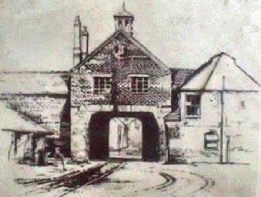
The Staton family was related by marriage to the Newton family and together formed an early partnership in the company.
Henry Newton took control of the firm in 1899 on the death of his uncle William Newton. The conversion of the Tutbury mill was his responsibility.
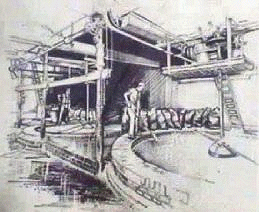
Statons had no plaster manufacturing facility at Fauld and was made at Shobnall in Burton-on-Trent. In 1890, Henry Newton leased, and later bought the disused cotton mill situated on Butt Green 'Common land on either side of the present Bridge Street', for the manufacture of plaster.
New water turbines had been installed in 1880, and these proved invaluable in driving the crushing and calining plants.
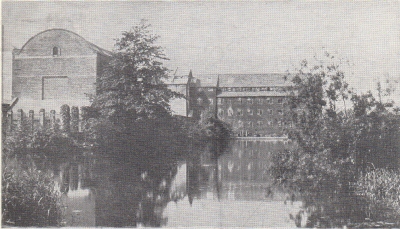
Tutbury Cotton Mill 1781 to 1888
The rock was mined, sorted and then transported to Scropton sidings on the 3ft gauge railway using a steam locomotive. The mineral was then loaded onto main line gauge trucks and taken to their recently acquired mill at Tutbury.
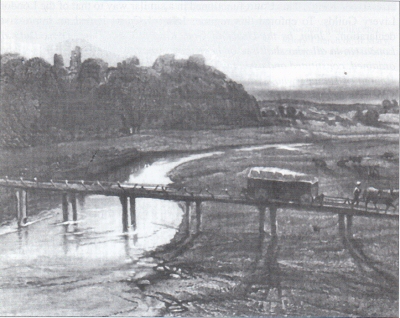
18th century engraving of the railway over the Dove
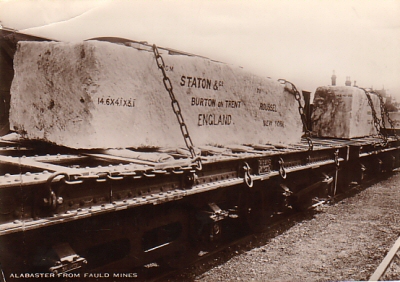
Alabaster from the Fauld Mines
Henry was joined in 1901 by his brother-in-law, T.Trafford Wynne, a mining engineer who took charge of the mining operations.
In 1911 Henry Newton's son Leigh Newton became assistant to his father. About this time Statons had a very famous tug-of-war team; they were champions at the Burton-on-Trent Flower Show and defeated the All England Champions.
Local plaster was used in the ceiling of the Tower ballroom in Blackpool and local alabaster was used for Cornelius Vanderbuilt's mansion in the USA.
In October 1968, the mill closed and was demolished in 1972 after 78 years in the service of the gypsum industry.
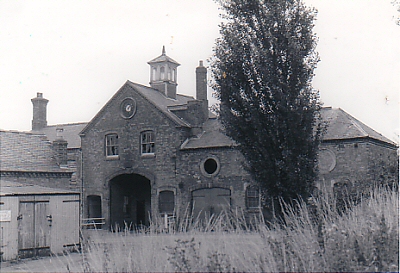
The plaster mill just before demolition in 1968
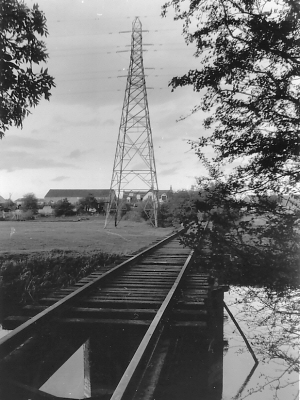
The railway line in 1986 - now removed
Alabaster is the result of fashioning and polishing natural stone, but to manufacture plaster it is necessary to reduce the moisture content from 20% to 5% or 6%. This process, known as calining, was carried out at Tutbury by means of `Pans', flat bottomed, 15 feet circular hearths under which ran flues heated by coal fires. From a vertical shaft in the centre, were fastened horizontal ones extending to the edge of the hearth, which in turn held chains 'to keep the powder agitated during the 'Boiling' process.
The majority so made, went to the Potteries for potter's moulds, for chinaware, earthenware and sanitary ware. Before World War II, plaster made from lower grades of stone, went to the building industry. High class stone, baked in lumps and hand brushed, was used for the manufacture of Dental and Surgical, and modelling plaster known as Italian fine plaster.
Anhydrous or 'deadburnt' plaster, Keenes cement and Statite were also made, in this case all moisture was driven off and potash or potassium sulphate was added during manufacture. Hundreds of tons of plaster from Tutbury were used in the building of the Franco British Exhibition at the White City in 1908, and locally made Keenes cement played a big part in the erection of the Wembley Exhibition of 1925.
In 1952, under the auspices of Gyproc Ltd. and the British Plaster Board Ltd., a new plant was built to concentrate on building plasters, near the new mine mouth at Fauld. It is now the property of British Gypsum, who continue to manufacture plaster for the building industry. Today its output is many times that of the old mill.
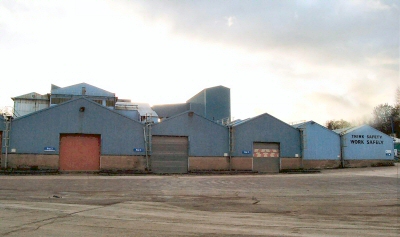
The Gypsum works at Fauld
